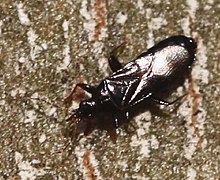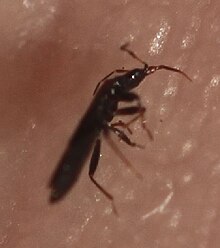Dufouriellus ater
| Dufouriellus ater | ||||||||||||
|---|---|---|---|---|---|---|---|---|---|---|---|---|

Dufouriellus ater |
||||||||||||
| Systematics | ||||||||||||
|
||||||||||||
| Scientific name of the genus | ||||||||||||
| Dufouriellus | ||||||||||||
| Kirkaldy , 1906 | ||||||||||||
| Scientific name of the species | ||||||||||||
| Dufouriellus ater | ||||||||||||
| ( Dufour , 1833) |
Dufouriellus ater is a species in the flower bug family(Anthocoridae). The genus Dufouriellus is monotypical , that is, it consists of only one species. This was first described as Xylocoris ater by Jean-Marie Léon Dufour in 1833, laterassigned toits own genus Dufouriellus . The type epithet ater comes from Latin and means "black".
features
The bugs are 1.9–2.4 mm long. They have a black basic color. The hemielytres do not cover the entire abdomen . The apical half of the membrane has a characteristic dark spot. The proboscis, tibiae and tarsi are reddish in color. The bugs are flattened dorsoventrally, which is an indication of their typical habitat.
distribution
Dufouriellus ater is native to the Palearctic . Their occurrence ranges from southern Scandinavia to northern Africa. The species is also represented in the British Isles . To the east, the distribution area extends over the Middle East and the Caucasus to Siberia and China . In Central Europe, Dufouriellus ater is present almost everywhere, but not often.
The bug species was introduced to North America by the beginning of the 20th century at the latest . It was first detected there in 1916. Its range extends on the west coast of California to British Columbia, including Idaho. The species is also represented in the east; finds exist from Ontario, Kentucky and North Carolina.
Way of life
Dufouriellus ater usually lives under the dry bark of dead wood. However, they can also be found on the trunks of various deciduous and coniferous trees , especially plane trees , the bark of which peels off annually. The adults are observed all year round. The species usually overwinters both as an imago and in the form of more mature nymphs . The eggs are laid in spring. The bugs predatory feed on the various stages of development of small insects (including dust lice ) and other arthropods.
Individual evidence
- ↑ a b Dufouriellus ater at Fauna Europaea. Retrieved December 18, 2019
- ↑ a b c d e f g Ekkehard Wachmann , Albert Melber, Jürgen Deckert: Bugs. Volume 1: Cimicomorpha: Dipsocoromorpha, Nepomorpha, Gerromorpha, Leptopodomorpha, Cimicomorpha (part 1) (= The animal world of Germany and the adjacent sea parts according to their characteristics and according to their way of life . 77th part). Goecke & Evers, Keltern 2006, ISBN 3-931374-49-1 , p. 203-205 .
- ↑ a b c d Species Dufouriellus ater . bugguide.net. Retrieved December 18, 2019.
Web links
- Photos of Imago and Nymph at www.golddistel.de (Ingrid Altmann)


